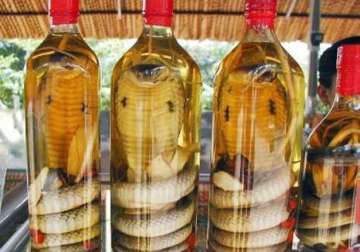Ever imagined a creepy, venomous creature nourishing your drink?
Though not really deadly but yes, a lot of alcoholic beverages in China are consumed after being nourished with the venom of snakes and other small creatures like scorpions. Locals believe that the reptiles add flavour to the drink and have medicinal value, as well.
People of China have always believed in the medicinal qualities of these venomous creatures. The followers of traditional Chinese medicines consider them highly for their curative virtues.
It is said that it revives a person and refreshes him. Locals believe that it can cure far-sightedness, hair loss, and even a few sip can improve sexual performance of a man.
Known to be a traditional outcome of China and relished till date, they originated hundreds of years back when people of Western Zhou Dynasty started consuming them - This was in the period 1046-771 BC. The tradition is still very much alive in the 21st century China and some south-east asian countries.
The toxic alcoholic beverages are made by infusing full snakes in an already alcoholic drink called rice wine or ethanol. Snakes are dipped into the drinks for their “essence” and “venom” which gets dissolved in the liquor. They are kept like this for months so that their body fluids can mix well with wine and make for a shot. The fatal venom of the snake gets denatured by the ethanol present in the drink which unfolds the proteins and hence makes it inactive.
They treat the drink in two different manners – Steeped or Mixed.
In case of steeped, a large venomous snake is placed in a glass jar of rice wine with some other smaller snakes and medicinal herbs. The jar is left to steep for a few months. After that it is consumed in small shots for its restorative purposes.
In case of mixed, the body fluids of snakes are mixed in wine directly and consumed immediately. A blood wine of snake is prepared by slicing a reptile from its belly and pouring its blood directly into the drink. The bile wine is prepared by using the contents of snake's gall bladder.
Such wines are common in several areas of Vietnam, Southeast Asia and Southern China.
